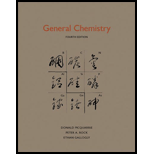
Concept explainers
(a)
Interpretation:
The colligative molality of a solution prepared by dissolving one mole of methanol in
Concept Introduction:
Molality:
Molality is defined as the number of moles of solute per
The colligative molality of a solution is the product of number of solute particles per formula unit and molality of solution. This can be represented as given below.
Where,
(a)
Answer to Problem 16.12P
The colligative molality of the resulting solution is
Explanation of Solution
Given that, one mole of methanol is dissolved
The molality of the resulting solution can be calculated as shown below.
For methanol,
Then, the colligative molality will be same as the molality.
Therefore, the colligative molality of the resulting solution is
(b)
Interpretation:
The colligative molality of a solution prepared by dissolving one mole of
Concept Introduction:
Refer to part (a).
(b)
Answer to Problem 16.12P
The colligative molality of the resulting solution is
Explanation of Solution
Given that, one mole of
The molality of the resulting solution can be calculated as shown below.
Then,
Therefore, the colligative molality of the resulting solution is
(c)
Interpretation:
The colligative molality of a solution prepared by dissolving one mole of
Concept Introduction:
Refer to part (a).
(c)
Answer to Problem 16.12P
The colligative molality of the resulting solution is
Explanation of Solution
Given that, one mole of
The molality of the resulting solution can be calculated as shown below.
Then,
Therefore, the colligative molality of the resulting solution is
(d)
Interpretation:
The colligative molality of a solution prepared by dissolving one mole of
Concept Introduction:
Refer to part (a).
(d)
Answer to Problem 16.12P
The colligative molality of the resulting solution is
Explanation of Solution
Given that, one mole of
The molality of the resulting solution can be calculated as shown below.
Then,
Therefore, the colligative molality of the resulting solution is
Want to see more full solutions like this?
Chapter 16 Solutions
General Chemistry
 ChemistryChemistryISBN:9781305957404Author:Steven S. Zumdahl, Susan A. Zumdahl, Donald J. DeCostePublisher:Cengage Learning
ChemistryChemistryISBN:9781305957404Author:Steven S. Zumdahl, Susan A. Zumdahl, Donald J. DeCostePublisher:Cengage Learning ChemistryChemistryISBN:9781259911156Author:Raymond Chang Dr., Jason Overby ProfessorPublisher:McGraw-Hill Education
ChemistryChemistryISBN:9781259911156Author:Raymond Chang Dr., Jason Overby ProfessorPublisher:McGraw-Hill Education Principles of Instrumental AnalysisChemistryISBN:9781305577213Author:Douglas A. Skoog, F. James Holler, Stanley R. CrouchPublisher:Cengage Learning
Principles of Instrumental AnalysisChemistryISBN:9781305577213Author:Douglas A. Skoog, F. James Holler, Stanley R. CrouchPublisher:Cengage Learning Organic ChemistryChemistryISBN:9780078021558Author:Janice Gorzynski Smith Dr.Publisher:McGraw-Hill Education
Organic ChemistryChemistryISBN:9780078021558Author:Janice Gorzynski Smith Dr.Publisher:McGraw-Hill Education Chemistry: Principles and ReactionsChemistryISBN:9781305079373Author:William L. Masterton, Cecile N. HurleyPublisher:Cengage Learning
Chemistry: Principles and ReactionsChemistryISBN:9781305079373Author:William L. Masterton, Cecile N. HurleyPublisher:Cengage Learning Elementary Principles of Chemical Processes, Bind...ChemistryISBN:9781118431221Author:Richard M. Felder, Ronald W. Rousseau, Lisa G. BullardPublisher:WILEY
Elementary Principles of Chemical Processes, Bind...ChemistryISBN:9781118431221Author:Richard M. Felder, Ronald W. Rousseau, Lisa G. BullardPublisher:WILEY





